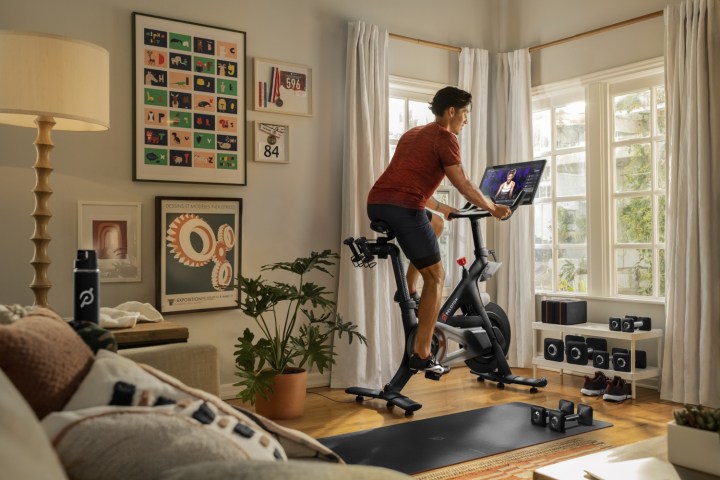Home fitness was heating up even before the pandemic shut down gyms and sent most of us home. Those inspiring home gym setups showed that it’s possible to create a customized setup that caters to individual workout styles and preferences right from your own living room or garage.
Peloton was the first company to crystallize this public demand (even pre-pandemic) and the company’s video-connected stationary bike offers customers live workouts and feedback from trainers. The price point became a status symbol of sorts, and people took to social media to share their lists of best workouts and favorite trainers. Soon after, companies like NordicTrack and ProForm took notice and expanded upon unique exercise options focusing on connectivity and user feedback.
If you’re shopping for an at-home workout system, Peloton is no doubt at the top of your Google search list — but what else is out there?
Today, we’ll compare the similarities and differences between the ProForm Vue and the Peloton Bike. Yes, these are different pieces of equipment, and this may be a bit of an apples-to-oranges comparison, but hear us out: Folks who need to get in shape may not yet be loyal to a method, system, or piece of equipment and are likely shopping for a system they can grow with. This is the place to find out more about what you can expect from two popular pieces of connected home fitness equipment.
What is ProForm Vue?

The ProForm Vue is a large fitness mirror with a built-in touchscreen. This allows users to work out with a live trainer or use pre-recorded sessions to match their form. It comes with 30 pounds of weights that attach to the back of the mirror and has built-in speakers, so you can hear a workout.
What is a Peloton Bike?

Peloton has a few different versions of its Bike and different packages with different options. At its core, it’s a stationary spin bike with a touch screen that allows you to work out with a live trainer or access a library of pre-recorded sessions. Users can adjust the height and tension of the Bike to adapt to their own needs and abilities.
Hardware
From a hardware standpoint, you’re either buying an expensive mirror that acts as a screen with sound output along with some weights or a costly stationary bike that has a screen and sound output. Some Bike packages also include biking shoes, bike mats, a light set of weights, and a heart-rate band.
Without the connectivity and online content, you have a nice-looking mirror that talks or a large bike that spins. Either way, you’re going to need a dedicated space in your home for whichever equipment you choose.
Winner: Tie. Since both take up substantial floor space, we’ll score things evenly.
Size
Floor space might be an issue for some, and that’s where a big difference between these two devices appears. The ProForm Vue is 24.25 x 14 inches and 72.65 inches tall. It has a rotating base to allow you to access the weight holders on the back, but otherwise, it won’t take up a lot of floor space. You can also use it as a mirror when you’re not working out. You’ll obviously need some space in front of it to exercise.
The Peloton Bike has a 48 x 24-inch profile and is 65 inches tall. You’ll need that much space just to store the Bike when not in use. It’s easy enough to roll the bike to your chosen location by tilting it. Peloton’s suggestions for storage include removing a living room chair in favor of the Bike or just, you know, keeping it out so all your visitors can see your status symbol.
Winner: ProForm Vue, hands down.
Price
If we cut to the chase, The Peloton Bike will cost you twice or close to three times what the Vue costs.
The ProForm Vue is selling for $1,499. That price includes the Vue mirror, a 10-pound barbell, two 5-pound dumbbells, and four 2.5 weight plates, all of which clip to the backside of the Vue mirror. It also includes an iFIT Family membership and 30 days of free streaming of live and on-demand fitness. Shipping is free, and there’s a 30-day money-back guarantee. The Vue has a two-year warranty on the frame and one year one on parts and labor. ProForm offers financing at $39 per month for 39 months at 0% APR.
The Peloton Bike has a number of packages, but the Starter package sells for $1,495 plus delivery and setup ($350). It includes the Bike, a 12-month limited warranty, cycling shoes, some light weights, and a bike mat. The subscription fee to the All-Access program is $39 a month. Peloton offers a 100-day home trial with a full refund and financing as low as $45 per month for 39 months at 0% APR.
Winner: ProForm, because it includes more in its basic package.
Subscription fees
Both Peloton and ProForm rely on a fitness subscription service to provide content and link users to live workouts. (And if we’re being honest, it’s how they keep making money after selling you the equipment.)
ProForm’s iFIT app costs $39 per month (new users get 30 days free). The whole family can use a single membership, and the app is required to access live and on-demand workouts.
Peloton’s All-Access Membership costs $39 per month, and new users can get 30 days free. The entire family can use a single membership, and the app is necessary to get live and on-demand classes and fitness tracking.
Winner: Tie.
Content
iFit (which ProForm uses to provide content) claims to have a library of over 16,000 live and on-demand classes ranging from yoga to strength to cardio. It’s important to note that iFit also works with NordicTrack, so there’s both more potential use if you own other devices and many workouts that might only work with some of those devices.
Peloton boasts 14 different types of programs in their app but doesn’t list the total number of available programs. Like iFit, the Peloton app is made to work with their various gear, so some programs will be treadmill-only, bike-only, etc. Users rave about the variety and breadth of workouts.
Winner: Tie.
Screen Size
The ProForm Vue has a 22-inch vertical high-definition touchscreen built-in to the mirror that becomes “invisible” when turned off. The Peloton Bike has a 21.5-inch high-definition touchscreen that looks more like a tablet strapped to the bike.
Winner: ProForm Vue. Having not had the opportunity to do touch-test comparisons with each of these screens to see how well they respond, we’ll rank this one on size alone, with points to ProForm for its ability to vanish into the mirror and hide in plain sight.
Weight
Weight might be a factor if you need to frequently reposition your workout area. The ProForm Vue weighs 140 pounds, while the Peloton Bike weighs 135 pounds.
Winner: Peloton.
Exercise Style
Which workout system you choose will have a lot to do with your own personal fitness goals. Those who want to focus on cardio or weight loss might pick the Peloton Bike, while those interested in core strength, agility, stretching, and muscle-building may go for the ProForm Vue. In truth, apart from the online connectivity and live classes, they’re very different beasts.
Winner: Tie. You be the judge.
Overall winner: ProForm Vue
It’s difficult to declare a winner here, as there are a lot of factors involved that might sway your own opinion. Either will help you achieve fitness goals and hopefully encourage you to keep on exercising. Even so, looking at the simple specs head to head here, ProForm may have a slight edge — primarily thanks to its narrow footprint, the fact it hides in plain sight as a mirror, and the fact that it costs far less than a Peloton.





